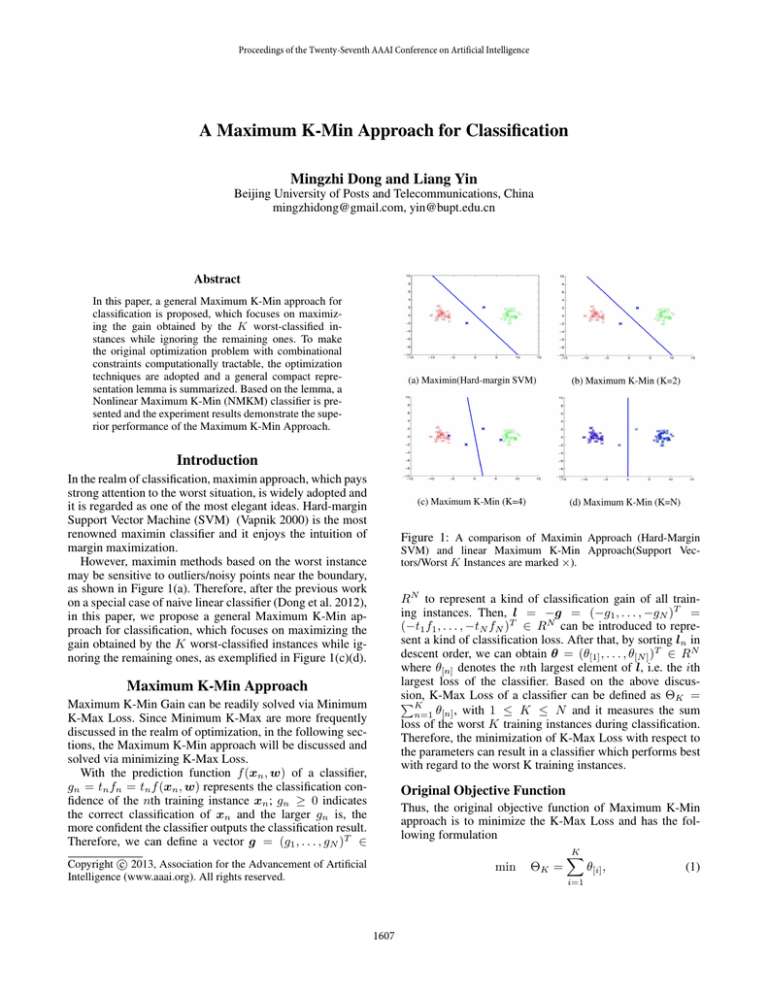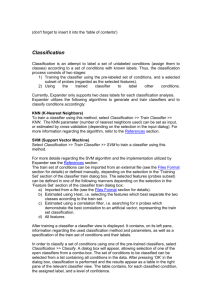
Proceedings of the Twenty-Seventh AAAI Conference on Artificial Intelligence
A Maximum K-Min Approach for Classification
Mingzhi Dong and Liang Yin
Beijing University of Posts and Telecommunications, China
mingzhidong@gmail.com, yin@bupt.edu.cn
Abstract
In this paper, a general Maximum K-Min approach for
classification is proposed, which focuses on maximizing the gain obtained by the K worst-classified instances while ignoring the remaining ones. To make
the original optimization problem with combinational
constraints computationally tractable, the optimization
techniques are adopted and a general compact representation lemma is summarized. Based on the lemma, a
Nonlinear Maximum K-Min (NMKM) classifier is presented and the experiment results demonstrate the superior performance of the Maximum K-Min Approach.
Introduction
In the realm of classification, maximin approach, which pays
strong attention to the worst situation, is widely adopted and
it is regarded as one of the most elegant ideas. Hard-margin
Support Vector Machine (SVM) (Vapnik 2000) is the most
renowned maximin classifier and it enjoys the intuition of
margin maximization.
However, maximin methods based on the worst instance
may be sensitive to outliers/noisy points near the boundary,
as shown in Figure 1(a). Therefore, after the previous work
on a special case of naive linear classifier (Dong et al. 2012),
in this paper, we propose a general Maximum K-Min approach for classification, which focuses on maximizing the
gain obtained by the K worst-classified instances while ignoring the remaining ones, as exemplified in Figure 1(c)(d).
Figure 1: A comparison of Maximin Approach (Hard-Margin
SVM) and linear Maximum K-Min Approach(Support Vectors/Worst K Instances are marked ×).
RN to represent a kind of classification gain of all training instances. Then, l = −g = (−g1 , . . . , −gN )T =
(−t1 f1 , . . . , −tN fN )T ∈ RN can be introduced to represent a kind of classification loss. After that, by sorting ln in
descent order, we can obtain θ = (θ[1] , . . . , θ[N ] )T ∈ RN
where θ[n] denotes the nth largest element of l, i.e. the ith
largest loss of the classifier. Based on the above discussion,
PK K-Max Loss of a classifier can be defined as ΘK =
n=1 θ[n] , with 1 ≤ K ≤ N and it measures the sum
loss of the worst K training instances during classification.
Therefore, the minimization of K-Max Loss with respect to
the parameters can result in a classifier which performs best
with regard to the worst K training instances.
Maximum K-Min Approach
Maximum K-Min Gain can be readily solved via Minimum
K-Max Loss. Since Minimum K-Max are more frequently
discussed in the realm of optimization, in the following sections, the Maximum K-Min approach will be discussed and
solved via minimizing K-Max Loss.
With the prediction function f (xn , w) of a classifier,
gn = tn fn = tn f (xn , w) represents the classification confidence of the nth training instance xn ; gn ≥ 0 indicates
the correct classification of xn and the larger gn is, the
more confident the classifier outputs the classification result.
Therefore, we can define a vector g = (g1 , . . . , gN )T ∈
Original Objective Function
Thus, the original objective function of Maximum K-Min
approach is to minimize the K-Max Loss and has the following formulation
c 2013, Association for the Advancement of Artificial
Copyright Intelligence (www.aaai.org). All rights reserved.
min
ΘK =
K
X
i=1
1607
θ[i] ,
(1)
Equation 1 is a convex optimization problem as follows
min
s
s.t.
where
s,
yi1 + · · · + yiK ≤ s,
1 ≤ i1 ≤ · · · ≤ iK ≤ N,
Compact Representation of ΘK
However, it’s prohibitive to solve an optimization problem
K
under CN
inequality constrains. We need to sketch out a
compact formulation. Thus, with the convex optimization
techniques (Boyd and Vandenberghe 2004), we introduce
the following lemma.
Lemma 1 For a fixed integer K, ΘK (y), the sum of K
largest elements of a vector y, is equal to the optimal value
of a linear programming problem as follows,
max
z
s.t.
As a Quadratically Constrained Linear Programming
(QCLP) problem, standard convex optimization methods,
such as interior-point methods (Boyd and Vandenberghe
2004), can also be adopted to solve the above problem efficiently and a global maximum solution is guaranteed.
y T z,
0 ≤ zi ≤ 1,
P
i zi = K,
where i = 1, . . . , N ,z = {z1 , . . . , zN }.
According to Lemma 1, we can obtain an equivalent representation of ΘK . The dual of this equal representation can
be written as
P
Ks + i ui
min
Experiment
The algorithm of NMKM (with RBF kernel) is compared
with two state-of-the-art classifiers of Support Vector Machine (SVM) (with RBF kernel) and Logistic Regression
(LR) (L2-regularized). Ten UCI datasets for binary classification are adopted in the experiment. Our algorithm is deployed using cvx toolbox1 in matlab environment and kernel
SVM is deployed using libsvm toolbox2 . The hyperparameters of NMKM and SVM are chosen via cross-validation.
As shown in Table 1, among 10 different datasets, NMKM
achieves best accuracy in 6 datasets. SVM performs best
in 2 datesets and LR shows best performance in 2 datasets.
Among all datasets which SVM or LR performes better than
NMKM, NMKM performs slightly weaker than SVM or
LR. While for datasets which NMKM gains better performance, the accuracy of NMKM may be much larger than
MSVM and LR. The accuracy gap of SVM in dataset liver
and LR in dataset fourclass from NMKM is 8.86% and
27.85% respectively.
Thus we can conclude, compared with SVM and LR,
NMKM has shown competitive classification performance,
which verifies the efficiency of Maximum K-Min approach.
s,ui
s.t.
where
s + ui ≥ yi
ui ≥ 0
i = 1, . . . , N.
According to the above conclusion, the minimization of
ΘK (y), i.e. the original Maximum
P K-Min problem, is equal
to the minimization of Ks + i ui under 2N constraints.
A Nonlinear Maximum K-Min Classifier
To utilize kernel in non-linear separable situations, we make
a linear assumption of the prediction function f (x)
f (x) =
N
X
an k(x, xn )tn + b,
n = 1, . . . N
(2)
n=1
where k(x, xn ) denotes a similarity measurement between
x and xn via a kind of kernel function. a = {a1 , . . . , aN }
denotes the weight of training samples in the task of classification. b indicates the bias. tn indicates the corresponding target value and tn ∈ {−1, 1}. The prediction of x is
made by taking weighted linear combinations of the training
set target values, where the weight is the product of an and
s(x, xn ). Therefore, the classification confidence measurement g(x) equals tn f (x).
According to the above discussion, we can obtain a compact representation for this Nonlinear Maximum K-Min
Classifier (NMKM) as follows
PN
min
Ks + i=1 ui ,
a,s,u
PN
s.t.
n=1 an tn k(xi , xn ) + tn b − s − ui ≤ 0,
ui ≥ 0,
aT a ≤ 1,
where
i = 1, . . . , N.
References
Boyd, S., and Vandenberghe, L. 2004. Convex optimization.
Cambridge Univ Press.
Dong, M.; Yin, L.; Deng, W.; Wang, Q.; Yuan, C.; Guo, J.;
Shang, L.; and Ma, L. 2012. A linear max k-min classifier. In Pattern Recognition (ICPR), 2012 21st International
Conference on, 2967–2971. IEEE.
Vapnik, V. 2000. The nature of statistical learning theory.
Springer-Verlag New York Inc.
1
2
1608
http://cvxr.com/
www.csie.ntu.edu.tw/ cjlin/libsvm







